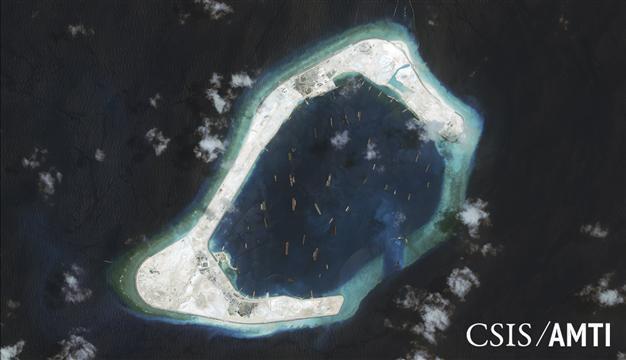Beijing may build 3rd S. China Sea runway: US think-tank
BEIJING – Agence France-Presse

Subi Reef is shown in this handout satellite image dated September 3, 2015 and provided by CSIS Asia Maritime Transparency Initiative/Digital Globe September 14, 2015. China appears to be building a third airstrip in contested territory in the South China Sea, a U.S. expert said Monday, citing satellite photos taken last week. REUTERS/CSIS Asia Maritime Transparency Initiative
Beijing may be building its third airstrip on artificial islands in the South China Sea, a US think-tank said, in a move likely to raise tensions with Washington ahead of a state visit by China's president.China claims almost the whole of the sea and over the past year has asserted its stance with rapid conversion of tiny reefs into islands for facilities with military uses.
Taiwan, Vietnam, the Philippines, Malaysia and Brunei all have rival claims to the waters, which incorporate strategically crucial shipping lanes and could harbour oil and gas deposits.
The Pentagon has warned that Beijing's activities are changing the regional status quo, and has weighed sending warships and surveillance aircraft within 12 nautical miles -- the normal territorial zone around natural land -- of the new artificial islands.
Work began last year on a 3,000-metre (9,842 feet) runway on Fiery Cross reef in the Spratly islands, around 1,000 kilometres from China's island province of Hainan.
It is now "well advanced" and has reached the painting stage, said the Washington-based Center for Strategic and International Studies (CSIS) on Sept.15.
Satellite photos of another reef, Subi, where nearly four million square metres (988 acres) of land have been reclaimed, show grading work and possible runway construction is being carried out, it said.
And satellite photos taken last week show that a retaining wall has been built on Mischief Reef, creating a 3,000-metre rectangular area, and a cement plant set up, CSIS said, "suggesting another runway could be in the works".
The images appear to contradict a claim by China in August that its reclamation activities had stopped.
Mischief Reef is only 21 nautical miles from Second Thomas Shoal, where the Philippines -- whose defence budget is a fraction of China's -- deliberately grounded a landing ship in 1999 to serve as a makeshift base for a contingent of marines.
"A third airstrip on Mischief Reef... would complete the triangle, significantly boosting China's air patrol and interdiction capabilities over the contested waters and features of the Spratlys," wrote Gregory Poling of CSIS' Asia Maritime Transparency Initiative (AMTI).
It would heighten tensions and present "greater operational headaches for all the claimants as well as outside players like the United States", he added.
Airstrip building in the Spratlys goes back nearly 40 years and four other claimants already have such facilities, although China's are much longer and could be used by any of the People's Liberation Army's aircraft, analysts say.
China says its reclamations and facilities are intended for civilian and well as military purposes.
The latest satellite pictures -- showing continuing dredging and channel widening -- were taken after Chinese foreign minister Wang Yi said at an ASEAN summit in Kuala Lumpur last month that land reclamation works were over.
"China has already stopped. You look, who is building? Take a plane and look for yourself," Wang told reporters on the sidelines of the meeting.
Bonnie Glaser of AMTI said the works "underscore Beijing's unwillingness to exercise self-restraint and look for diplomatic paths to reduce tensions with its neighbours, the United States, and other nations".
Chinese President Xi Jinping will make his first state visit to the US next week and she added: "Beijing appears to be sending a message to President Barack Obama that China is determined to advance its interests in the South China Sea even if doing so results in heightened tensions with the United States."
















